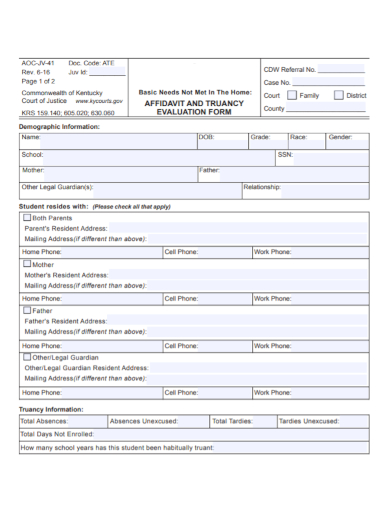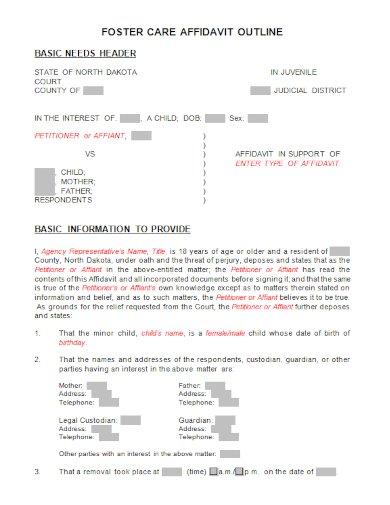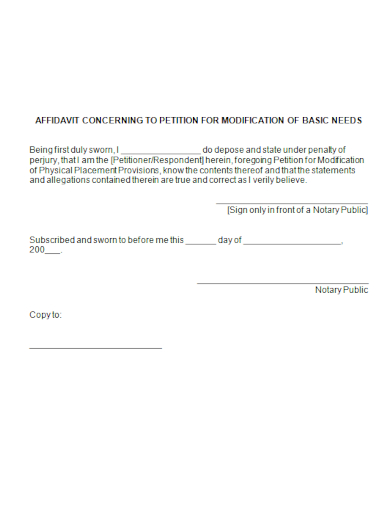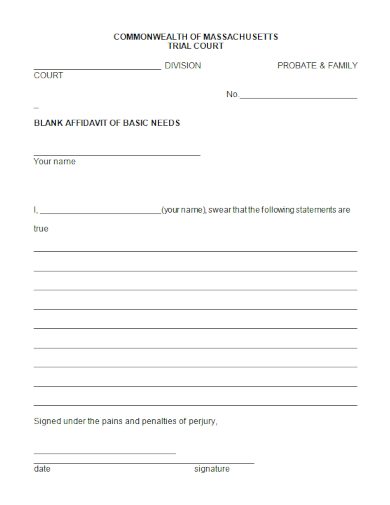An affidavit is a written statement that contains truth given by an individual under oath by a court of law. This statement is given to law enforcement officials or notaries and if it contains false information, the affiant will be subjected to face criminal charges for perjury. Affidavit letters are commonly completed by any individual but must be notarized before they are considered authentic. This document is signed by the affiant or the person making the statement and the person who is legally authorized to administer the oath.
3+ Affidavit of Basic Needs Samples
1. Affidavit Evaluation of Basic Needs
2. Affidavit Outline of Basic Needs
3. Affidavit Petition of Basic Needs
4. Blank Affidavit of Basic Needs
What is an Affidavit of Basic Needs?
An affidavit is a formal letter and legal document often required in court proceedings and acts as evidence of the individual providing the affidavit. This document contains the signature of the individual giving the affidavit and is witnessed by a lawyer or other qualified person. An affidavit is similar to the witness’s sworn testimony in court and must swear that what they will say is true and accurate under the penalty of perjury.
How to Create an Affidavit?
Most courts only accept affidavits that were written and witnessed according to their requirements. This document can be used in many situations and many government forms involving affidavits like driver’s license applications, voter registrations, vehicle registration, and concealed weapon permits. Affidavits are also an essential part of court proceedings as they include written information on the details that comes with a case, making it easier for judges to decide a verdict.
Step 1: Provide the Title of the Document
Write the title of the affidavit to inform the receiver what the sworn statement is about, including your name and the objective or topic of the document. This section also includes the caption of the case which can be located on any relevant court documents. It also contains details such as the name of the court, county and state, and the names of all involved parties and their case numbers.
Step 2: Provide a Statement of Identity
The next section is the statement of identity which contains your personal information such as name, age, work, address, and other related information that can be useful to the case. This section describes who you are based on the facts you are about to disclose.
Step 3: Write a Section for Facts
The statement of truth is the section where you will swear that the information you are telling is true and accurate. This statement is equivalent to swearing under oath in a court of law. After the statement of truth is the statement of facts which is the longest part of the affidavit. The length of this section has no definite measurement but it must include all accurate information.
Step 4: Include your Signature and Get Notarized
After reviewing all the facts and providing a closing statement with another statement of truth, sign the affidavit and have it notarized. Complete the document before notarization but do not sign it unless you are with a licensed witness or notary.
FAQs
What are the common types of affidavits?
The most common types of affidavits are the affidavit of the name change, affidavit of death, affidavit of identity theft, affidavit of age declaration, affidavit of inheritance, affidavit of residence, divorce affidavit, child custody affidavit, and sworn statement affidavit.
What are the reasons for writing and signing an affidavit?
The reasons why a person is required to write and sign an affidavit are to provide details about an event, claim an inheritance, verify their address, a business record of their earnings, confirm receiving legal documents, and determine a child’s custody.
What are the basic elements of an affidavit?
An affidavit’s basic elements include a statement in which an affiant swears under oath to the accuracy of the information provided in the document, the details that are being sworn to, the signature of the affiant, and the verification of a notary or other official qualified to administer an oath.
What are the tips for writing an affidavit?
When writing an affidavit, remember to consider the appearance of the document like the format being used, make sure to introduce yourself, write in the first person about the facts you are providing, keep it simple, make it relevant, be specific, and provide copies of all essential documents.
An affidavit of basic needs is a written document that provides stated facts and is often needed in court proceedings, acting as evidence of the affiant. It contains the signature of the person giving the affidavit and must be properly witnessed and notarized by a lawyer or other qualified individual. Making a false statement is a violation of the law and can lead to imprisonment.
Related Posts
FREE 40+ Statement Forms
FREE 29+ Sworn Statement Templates
FREE 24+ Sample Affidavit Forms
FREE 22+ Letter of Support Samples
FREE 16+ Sample CDL Medical Form
FREE 12+ Sample Domestic Partnership Agreement
FREE 11+ Sample Sworn Statement
FREE 8+ Car Rental Agreement Samples
FREE 6+ Sample Proof of Funds Letter
Printable Statement Forms
FREE 27+ Statement Formats & Samples
FREE 12+ Declaration Statement Samples
FREE 10+ Car Receipt Samples
FREE 10+ Sample Rental Verification Forms
FREE 9+ Sample Employee Exit Forms




